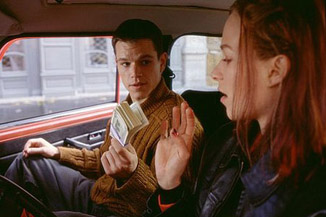Director's Spotlight
Doug Liman
By Joshua Pasch
February 2, 2010
Some directors have an easily identifiable style, while others refuse to be boxed in, continually reinventing themselves. After breaking into the Hollywood mainstream with the consecutive late '90s indie hits, Swingers and Go, Doug Liman established himself as someone who might fit into the second category of directors. Swingers is practically legend on college campuses around the country – instantly conjuring up one-liners ("You're so money and you don't even know it"). And Go is an adrenaline-fueled, compact little movie that was praised for strong visuals and, like Swingers, for its fast-paced, witty dialogue. Studios began to take notice, and Liman became the perfect candidate to take his energetic and efficient style of moviemaking to the big leagues. His last three films have all been big budget studio projects, and while not without their critical appeal, Liman seems to be boxing himself into a big-budget niche. Let's shine the director's spotlight on each of those three films, and see how Liman is trending as he moves into this decade.
The Bourne Identity
Every now and again, a movie comes along that, while not entirely genre redefining (a la The Matrix for science fiction), can at least be described as reasonably impacting. The Bourne Identity is such a film. The spy that helped to reinvent what Bond was supposed to be, Jason Bourne defied conventions of the spy-thriller sub-genre. He was blunt where he should have been suave, confused where he should have been controlled, and he was all the more thrilling for his shortcomings. He managed to show audiences that even though a movie can feature guns and an unlikely on-the-run romance, it doesn't need to feel like tired clichés of an overplayed genre. And, in the process, he cemented Matt Damon as a bona fide action star of the 2000s – one who is arguably bigger now than his Ocean's 11 counterparts. The movie, like Liman's previous small-scale productions, moved through its two-hour runtime with all the efficiency of a Bourne assassination, with an exhilarating Mini Cooper car chase thrown in for good measure.
Liman's first big gig was met with a rapturous response, as critics and audiences alike helped the movie earn a solid $27 million opening weekend. Critical strength and strong word-of-mouth helped Bourne climb over $121 million domestically and $214 million worldwide, which it later parlayed into some of the top DVD sales for that year. The results were even more impressive given Bourne's relatively modest $60 million budget.
Despite his immediate ascendance into the upper echelon of mainstream Hollywood, Liman was barred by one studio in particular: Universal. In fact, the drama and tension onscreen in Bourne Identity might have only been rivaled by the drama taking place behind screen between Liman and the Universal brass. Universal was the studio behind the Bourne trilogy, and despite the critical accolades and the financial windfall of Liman's work, Universal executives swore never to work with the director again. Liman's sets were famous for what was eventually coined in a 2008 article in New York Magazine as "Limania," a term meant to explain the chaotic way he ran a film set. His devil-may-care attitude was a competitive advantage in the indie-world, where avoiding permits and rewriting his movie's ending posed limited consequences and unlimited potential. But that same formula caused plenty of heartaches at Universal, and with that heartache, they opted to switch to Paul Greengrass for Bourne's second and third installments.
Continued:
1
2
3
|
|
|
|




